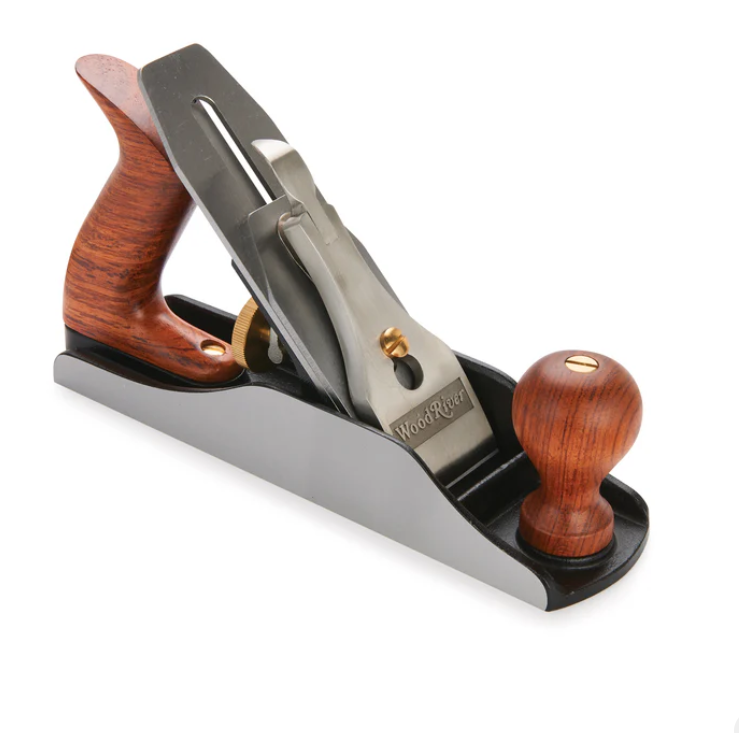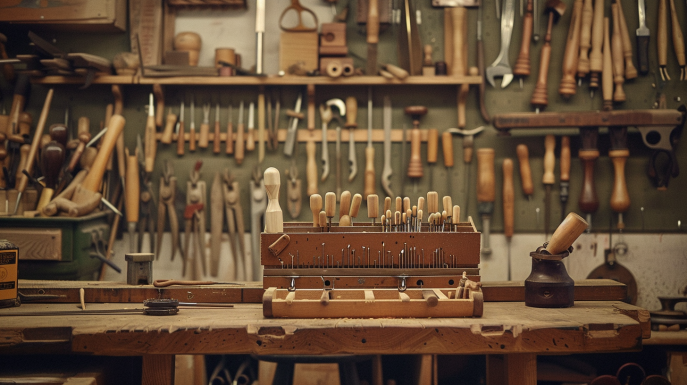
Bench Hand Plane – Smoothing Plane – V3
- Modeled after the Bedrocks, Stanley Tool’s very best line
- Heavy castings (5 lbs.) and fully machined frogs
- Lightly finished hardwood handles provide comfort and control
- Soles and sides are machined flat and square within tightly held tolerances
- Commonly known as a smoothing plane
- Tools require minimal tune-up prior to use
Unleashing Precision and Craftsmanship in Every Stroke
Woodworking is an art form that demands precision, patience, and the right tools. Among these tools, the bench plane stands out as a true game-changer. Today, we’re diving deep into the world of Woodriver Bench Planes, a brand that has been making waves in the woodworking community. Whether you’re a seasoned craftsman or a curious beginner, this comprehensive guide will help you navigate the ins and outs of these remarkable tools.
What’s the Buzz About Woodriver Bench Planes?
Imagine running your hand along a piece of wood so smooth it feels like glass. That’s the magic a quality bench plane can bring to your projects. Woodriver, a brand under the umbrella of Woodcraft, has been turning heads with their line of bench planes that promise professional results without breaking the bank.
At its core, a Woodriver Bench Plane is a hand tool designed for smoothing, shaping, and finishing wood surfaces. But it’s so much more than that. It’s a precision instrument that, in the right hands, can transform rough lumber into works of art. The beauty of Woodriver planes lies in their ability to combine traditional design with modern manufacturing techniques, resulting in tools that feel like old friends but perform like cutting-edge instruments.
Standing Tall Among Giants: Woodriver vs. the Competition
In a market dominated by big names like Stanley and Lie-Nielsen, Woodriver has carved out a niche for itself. How do they stack up? Well, let’s just say they’re punching above their weight class. While they may not have the century-old pedigree of some brands, Woodriver planes offer a compelling mix of quality and affordability that’s hard to ignore.
Compared to budget options, Woodriver planes feel like a significant step up in terms of build quality and performance. The cast iron bodies are well-machined, the blades hold an edge well, and the overall fit and finish are impressive. When pitted against premium brands, Woodriver holds its own, offering comparable performance at a more accessible price point. It’s like getting business class comfort without the first-class ticket price.
Where to Snag Your Own Woodriver Plane
Ready to add a Woodriver plane to your arsenal? Your best bet is to start with Woodcraft, the parent company. They offer the full range of Woodriver planes both in-store and online. For those who prefer to touch and feel before buying, Woodcraft’s physical stores are a woodworker’s playground. Online shoppers aren’t left out either – detailed product descriptions and customer reviews make virtual shopping a breeze.
Don’t forget to check out other authorized retailers and even second-hand markets. Sometimes, you can snag a great deal on a gently used Woodriver plane that just needs a little TLC to shine again.
A Plane for Every Purpose: Types of Woodriver Bench Planes
Woodriver offers a variety of bench planes, each designed for specific tasks:
- No. 4 Smoothing Plane: The go-to for final smoothing and finishing.
- No. 5 Jack Plane: A versatile workhorse for rough stock removal and initial smoothing.
- No. 6 Fore Plane: Ideal for flattening long boards.
- No. 7 Jointer Plane: Perfect for creating straight, square edges.
- Block Planes: Smaller planes for end grain and detail work.
Each type has its strengths, and many woodworkers find themselves collecting multiple planes as their skills and projects evolve.
From Novice to Pro: Using Your Woodriver Bench Plane
Getting started with a bench plane can be intimidating, but it’s a skill worth mastering. Here’s a quick primer:
- Adjust the blade depth for the desired cut.
- Hold the plane at a slight angle to the wood grain.
- Push the plane forward smoothly, letting the weight of the tool do the work.
- For smoother results, take thin shavings rather than trying to remove too much at once.
- Practice on scrap wood to get a feel for the tool before tackling your project.
Remember, using a plane is as much about feel as it is technique. With practice, you’ll develop an intuition for how the plane interacts with different woods and grain patterns.
The Perks of Planing: Benefits of Using a Woodriver Bench Plane
Why bother with a hand plane when power tools exist? The benefits are numerous:
- Precision: Achieve a level of smoothness and flatness that’s hard to match with power tools.
- Control: Fine-tune your work with a level of control that machines can’t provide.
- Quieter Operation: Enjoy woodworking without the noise of power tools.
- No Dust: Say goodbye to sawdust clouds and hello to beautiful wood shavings.
- Connection to Craft: There’s something deeply satisfying about shaping wood by hand.
Keeping the Edge: Sharpening Your Woodriver Plane Blade
A sharp blade is the heart of a well-performing plane. Here’s a basic sharpening routine:
- Flatten the back of the blade on a coarse stone.
- Progress through finer grits, ending with a polishing stone.
- Sharpen the bevel using a honing guide for consistent angles.
- Finish with a strop for a razor-sharp edge.
Invest in quality sharpening stones and make blade maintenance a regular part of your woodworking routine. A sharp blade makes all the difference between frustration and enjoyment.
Beginner-Friendly or Pro-Only? Woodriver’s Accessibility
One of Woodriver’s strengths is its appeal to both beginners and experienced woodworkers. For novices, these planes offer a quality tool that won’t hold you back as your skills improve. The learning curve is manageable, and the results can be incredibly rewarding.
For pros, Woodriver planes provide a cost-effective way to expand your tool collection without compromising on performance. They’re robust enough for daily use in a professional shop but won’t leave you sweating if an apprentice borrows one.
Dollars and Sense: The Cost of Woodriver Bench Planes
Pricing is where Woodriver really shines. While not the cheapest option on the market, they offer exceptional value for money. Expect to pay anywhere from $100 to $300 for a Woodriver bench plane, depending on the size and model.
When you consider the longevity of a well-made plane (we’re talking decades of use), the investment starts to look very attractive. It’s not uncommon for woodworkers to pass down their favorite planes to the next generation.
The Verdict: What Users Are Saying
Scan through woodworking forums and reviews, and you’ll find a lot of love for Woodriver planes. Users consistently praise:
- The quality of machining and overall fit and finish
- The performance right out of the box (with minimal tuning required)
- The value for money compared to both budget and premium alternatives
Of course, no tool is perfect. Some users note that the blades, while good, may not match the absolute best in edge retention. Others mention that some minor tuning might be needed for optimal performance. But overall, the consensus is overwhelmingly positive.
Caring for Your Woodriver: Maintenance Tips
To keep your Woodriver plane in top shape:
- Clean it after each use, removing wood chips and dust.
- Apply a light coat of oil to prevent rust, especially in humid environments.
- Store it in a dry place, ideally with a plane sock or in a tool chest.
- Periodically check and tighten any loose screws or adjustments.
- Keep the sole waxed for smooth operation.
With proper care, your Woodriver plane will be a faithful companion for years to come.
Versatility in Action: Hardwood vs. Softwood
One of the beauties of Woodriver planes is their versatility. Whether you’re working with rock-hard maple or soft pine, these planes can handle it all. The key is in the adjustments:
- For hardwoods, set the blade for a finer cut to avoid tearout.
- With softwoods, you can often take slightly deeper cuts.
- Always work with the grain for the best results.
Expanding Your Arsenal: Accessories for Woodriver Planes
While Woodriver planes are great out of the box, there are accessories to enhance your experience:
- Replacement blades for different types of work
- Blade sharpening jigs for consistent results
- Plane socks for storage and protection
- Specialized plane hammers for fine adjustments
Fine-Tuning Your Tool: Adjusting the Blade
Proper blade adjustment is crucial for optimal performance. Here’s a quick guide:
- Loosen the lever cap.
- Adjust the frog position for the desired mouth opening.
- Set the lateral adjustment lever to ensure the blade is parallel to the sole.
- Use the depth adjustment wheel to control how much blade protrudes.
- Test on scrap wood and fine-tune as needed.
Remember, small adjustments can make a big difference in performance.
Smooth Operator: The Best Woodriver for Finishing
For that glass-like finish, the Woodriver No. 4 Smoothing Plane is hard to beat. Its size and weight make it perfect for final smoothing passes, and with a well-tuned blade, it can produce shavings so thin you can read through them.
The Long Game: Are Woodriver Planes Worth It?
In a word: yes. Woodriver planes offer a compelling combination of quality, performance, and value that make them a smart investment for any woodworker. They’re built to last, perform admirably, and won’t break the bank. Whether you’re just starting out or looking to expand your tool collection, Woodriver deserves serious consideration.
Troubleshooting: Common Issues and Solutions
Even the best tools can have hiccups. Here are some common issues and how to address them:
- Chatter: Usually caused by a dull blade or improper adjustment. Sharpen the blade and check your settings.
- Tearout: Often occurs when planing against the grain. Adjust your technique or try a higher angle frog.
- Difficulty in adjusting: Clean and lubricate the adjustment mechanisms. If problems persist, check for any burrs or damage.
Bench Planes vs. Block Planes: Know Your Tools
While both are hand planes, bench planes and block planes serve different purposes:
- Bench planes are larger, designed for flattening and smoothing large surfaces.
- Block planes are smaller, ideal for end grain work and detail tasks.
Many woodworkers find they need both types in their toolkit.
Built to Last: The Lifespan of Woodriver Planes
With proper care, a Woodriver plane can easily last a lifetime. The cast iron body is virtually indestructible, and other components can be replaced if needed. It’s not uncommon for well-maintained planes to be passed down through generations of woodworkers.
Fan Favorites: Popular Woodriver Models
While preferences vary, some models consistently rise to the top:
- No. 4 Smoothing Plane: A versatile favorite for final finishing.
- No. 5 Jack Plane: The “jack of all trades” in the plane world.
- Low Angle Block Plane: Praised for its performance on end grain.
These models offer a great starting point for building your Woodriver collection.
In conclusion, Woodriver Bench Planes offer a compelling package for woodworkers of all levels. They combine quality craftsmanship with affordability, making them an excellent choice for those looking to elevate their woodworking game. Whether you’re smoothing a tabletop, squaring an edge, or putting the final touches on a cherished project, a Woodriver plane can help you achieve results that will make you proud. So why not give one a try? Your future projects (and your hands) will thank you.



